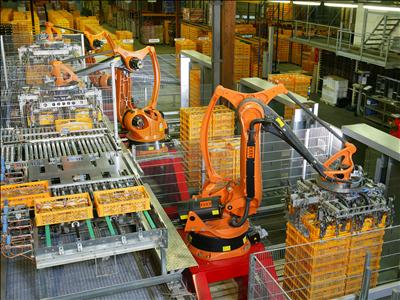This article was written by Yael Warman, Content Manager at Leverate.
From the Stone Age to the modern age, technology has left no stone unturned, and this is all the more true in the Forex
Forex
Foreign exchange or forex is the act of converting one nation’s currency into another nation’s currency (that possesses a different currency); for example, the converting of British Pounds into US Dollars, and vice versa. The exchange of currencies can be done over a physical counter, such as at a Bureau de Change, or over the internet via broker platforms, where currency speculation takes place, known as forex trading.The foreign exchange market, by its very nature, is the world’s largest tradi
Foreign exchange or forex is the act of converting one nation’s currency into another nation’s currency (that possesses a different currency); for example, the converting of British Pounds into US Dollars, and vice versa. The exchange of currencies can be done over a physical counter, such as at a Bureau de Change, or over the internet via broker platforms, where currency speculation takes place, known as forex trading.The foreign exchange market, by its very nature, is the world’s largest tradi
Read this Term industry. While on the one hand technology has made the market highly competitive and far more complex, on the other it has also provided excellent tools to help brokers increase their ROI. Having already looked at mobile trading platforms and digital marketing in part one, in this article we look at platform automation and social trading.
Join the industry leaders at the Finance Magnates London Summit, 14-15 November, 2016. Register here!
Platform Automation
Platform automation encompasses a broad segment of activities and can take several forms. Platform automation can be defined broadly as any situation in which trading can occur on an account without the trader undertaking immediate activity to open a position, usually through automated means.
Traditionally it relates to an API or algorithm (robot or signal) that a trader writes or downloads or the ability to set pending trades or stop losses of various complexities. Automation can also take the form of a trader’s account being linked to that of a money manager, other traders (via social trading) or to the activities of external traders.
Most recently however, and perhaps the use of automation that has had the most impact, is in the onboarding (conversion) and the retention processes, by way of automated flows in the form of messages at key points during a trader’s journey through the funnel.
Platform automation is a particularly powerful retention and sales tool and can offer a very unique 3-way win/win/win proposition. To use an introducing broker money manager as an example - simply offering the ability to link to PAMM or MAM accounts will attract money managers, who bring with them a referral base (simplifying sales processes and conversions). The traders will be attracted by the opportunity to have their accounts managed by a trading pro, and the money manager will be motivated to trade to generate profits and justify their profit share / monthly fee agreement with the linked clients. Attach the money manager to a revenue share deal based on volume and this will further increase trading volumes.
Profit will generate more referrals, more volume and more profits all around. Win for broker. Win for trader. Win for money manager.
Most of the software providers will enable traders to either upload an externally produced robot or produce a robot within the system. The use of these options varies between the ability to completely automate the actual trading process by opening and closing positions or by providing a notification for identified trading opportunities.
The market for self-produced robots is relatively small, but consists of serious, motivated traders, with significant technical skills and often an interest in expanding into affiliate work. Offering this will attract these high potential long term traders.
However, it is the externally produced robot that offers a significant volume of potential traders. Any Google search on FX will produce a mountain of these offerings, with strong, appealing, and often aggressive marketing. With the almost ubiquitous nature of these software offerings, providing this effectively gives your brokerage an expanded marketing presence.
Other offerings, be they software that predicts trades like Autochartist, internal MQL5 community signal providers or an external mirroring system like Zulutade or MirrorTrade, will provide options for traders looking to follow professionals. This is a significant enticement for beginner traders, who for either a small or no fee, can have their money managed by a professional. They can maintain control in the process, cut them off if they are doing poorly or increase their exposure if they are doing well. For an unsuccessful self-trader, these can be powerful retention tools.
Brokers utilizing automation during their conversion and retention funnels can effectively help them reduce the need for large sales teams. Automation flows are designed to reach out to customers via push notifications, SMS, e-mail, etc, at key points during the conversion process or by contacting them with messages that entice them to trade, thus increasing engagement.
Social Trading
Social trading functions in a very similar way to the above, however, rather than advertising the ability to follow a professional trader, it provides access to a network of like-minded, real traders more in the setting of social media platforms. This addresses one of the main pitfalls of the external signal providers above, in that there is the capacity for poor control of quality. This lack of quality can range from significant underperformance to automated robots trading on demo accounts to a variety of other possible scenarios. Social trading attempts to subvert this by providing a transparent user experience, to keep the traders honest and effective.
Automated trading offers different things to different traders, with each offering unique opportunities. It can help generate conversions for sales, provide options to help retain clients and generate affiliate opportunities and revenue, and even generate Leads
Leads
Leads or lead generation are an essential component of marketing and powerful tool by brokers. In its simplest form, leads can be defined as the outreach of customer interest or enquiry into products or services, most often associated with brokerages.These can be created for purposes such as list building, e-newsletter list acquisition, or for sales leads. Amongst marketers, such lists are one of their most important assets and instrumental to sales.There are a variety of methods for generating
Leads or lead generation are an essential component of marketing and powerful tool by brokers. In its simplest form, leads can be defined as the outreach of customer interest or enquiry into products or services, most often associated with brokerages.These can be created for purposes such as list building, e-newsletter list acquisition, or for sales leads. Amongst marketers, such lists are one of their most important assets and instrumental to sales.There are a variety of methods for generating
Read this Term directly from the affiliate.
From mobile trading to improving your penetration, to the unique potential of automated trading, technology tools in forex will help attract traders and provide them with the tools and access to undertake their trading effectively. Technological options are critical to the ongoing success of any brokerage and drive trading volumes and profits.
This article was written by Yael Warman, Content Manager at Leverate.
From the Stone Age to the modern age, technology has left no stone unturned, and this is all the more true in the Forex
Forex
Foreign exchange or forex is the act of converting one nation’s currency into another nation’s currency (that possesses a different currency); for example, the converting of British Pounds into US Dollars, and vice versa. The exchange of currencies can be done over a physical counter, such as at a Bureau de Change, or over the internet via broker platforms, where currency speculation takes place, known as forex trading.The foreign exchange market, by its very nature, is the world’s largest tradi
Foreign exchange or forex is the act of converting one nation’s currency into another nation’s currency (that possesses a different currency); for example, the converting of British Pounds into US Dollars, and vice versa. The exchange of currencies can be done over a physical counter, such as at a Bureau de Change, or over the internet via broker platforms, where currency speculation takes place, known as forex trading.The foreign exchange market, by its very nature, is the world’s largest tradi
Read this Term industry. While on the one hand technology has made the market highly competitive and far more complex, on the other it has also provided excellent tools to help brokers increase their ROI. Having already looked at mobile trading platforms and digital marketing in part one, in this article we look at platform automation and social trading.
Join the industry leaders at the Finance Magnates London Summit, 14-15 November, 2016. Register here!
Platform Automation
Platform automation encompasses a broad segment of activities and can take several forms. Platform automation can be defined broadly as any situation in which trading can occur on an account without the trader undertaking immediate activity to open a position, usually through automated means.
Traditionally it relates to an API or algorithm (robot or signal) that a trader writes or downloads or the ability to set pending trades or stop losses of various complexities. Automation can also take the form of a trader’s account being linked to that of a money manager, other traders (via social trading) or to the activities of external traders.
Most recently however, and perhaps the use of automation that has had the most impact, is in the onboarding (conversion) and the retention processes, by way of automated flows in the form of messages at key points during a trader’s journey through the funnel.
Platform automation is a particularly powerful retention and sales tool and can offer a very unique 3-way win/win/win proposition. To use an introducing broker money manager as an example - simply offering the ability to link to PAMM or MAM accounts will attract money managers, who bring with them a referral base (simplifying sales processes and conversions). The traders will be attracted by the opportunity to have their accounts managed by a trading pro, and the money manager will be motivated to trade to generate profits and justify their profit share / monthly fee agreement with the linked clients. Attach the money manager to a revenue share deal based on volume and this will further increase trading volumes.
Profit will generate more referrals, more volume and more profits all around. Win for broker. Win for trader. Win for money manager.
Most of the software providers will enable traders to either upload an externally produced robot or produce a robot within the system. The use of these options varies between the ability to completely automate the actual trading process by opening and closing positions or by providing a notification for identified trading opportunities.
The market for self-produced robots is relatively small, but consists of serious, motivated traders, with significant technical skills and often an interest in expanding into affiliate work. Offering this will attract these high potential long term traders.
However, it is the externally produced robot that offers a significant volume of potential traders. Any Google search on FX will produce a mountain of these offerings, with strong, appealing, and often aggressive marketing. With the almost ubiquitous nature of these software offerings, providing this effectively gives your brokerage an expanded marketing presence.
Other offerings, be they software that predicts trades like Autochartist, internal MQL5 community signal providers or an external mirroring system like Zulutade or MirrorTrade, will provide options for traders looking to follow professionals. This is a significant enticement for beginner traders, who for either a small or no fee, can have their money managed by a professional. They can maintain control in the process, cut them off if they are doing poorly or increase their exposure if they are doing well. For an unsuccessful self-trader, these can be powerful retention tools.
Brokers utilizing automation during their conversion and retention funnels can effectively help them reduce the need for large sales teams. Automation flows are designed to reach out to customers via push notifications, SMS, e-mail, etc, at key points during the conversion process or by contacting them with messages that entice them to trade, thus increasing engagement.
Social Trading
Social trading functions in a very similar way to the above, however, rather than advertising the ability to follow a professional trader, it provides access to a network of like-minded, real traders more in the setting of social media platforms. This addresses one of the main pitfalls of the external signal providers above, in that there is the capacity for poor control of quality. This lack of quality can range from significant underperformance to automated robots trading on demo accounts to a variety of other possible scenarios. Social trading attempts to subvert this by providing a transparent user experience, to keep the traders honest and effective.
Automated trading offers different things to different traders, with each offering unique opportunities. It can help generate conversions for sales, provide options to help retain clients and generate affiliate opportunities and revenue, and even generate Leads
Leads
Leads or lead generation are an essential component of marketing and powerful tool by brokers. In its simplest form, leads can be defined as the outreach of customer interest or enquiry into products or services, most often associated with brokerages.These can be created for purposes such as list building, e-newsletter list acquisition, or for sales leads. Amongst marketers, such lists are one of their most important assets and instrumental to sales.There are a variety of methods for generating
Leads or lead generation are an essential component of marketing and powerful tool by brokers. In its simplest form, leads can be defined as the outreach of customer interest or enquiry into products or services, most often associated with brokerages.These can be created for purposes such as list building, e-newsletter list acquisition, or for sales leads. Amongst marketers, such lists are one of their most important assets and instrumental to sales.There are a variety of methods for generating
Read this Term directly from the affiliate.
From mobile trading to improving your penetration, to the unique potential of automated trading, technology tools in forex will help attract traders and provide them with the tools and access to undertake their trading effectively. Technological options are critical to the ongoing success of any brokerage and drive trading volumes and profits.





















